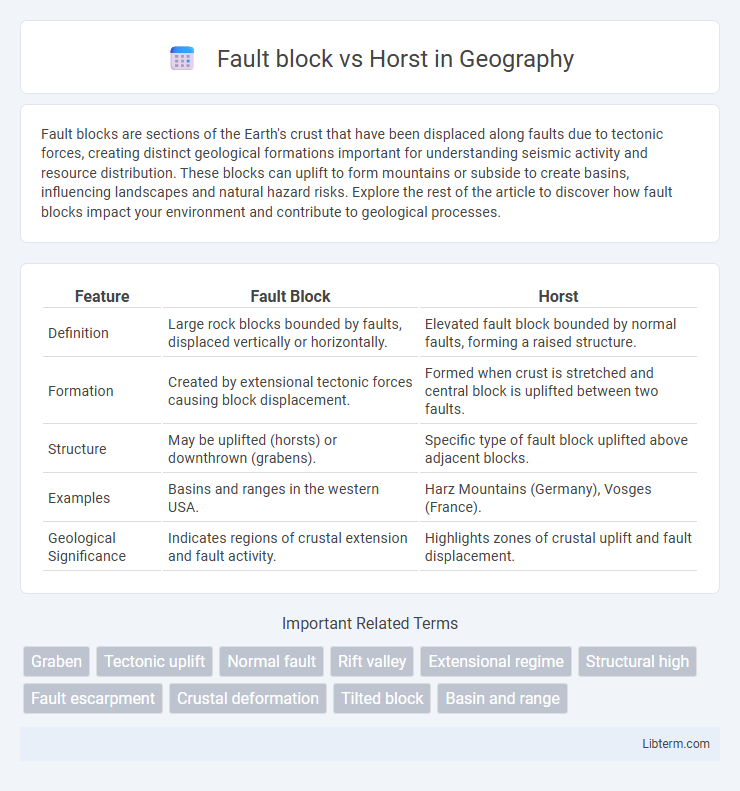Fault blocks are sections of the Earth's crust that have been displaced along faults due to tectonic forces, creating distinct geological formations important for understanding seismic activity and resource distribution. These blocks can uplift to form mountains or subside to create basins, influencing landscapes and natural hazard risks. Explore the rest of the article to discover how fault blocks impact your environment and contribute to geological processes.
Table of Comparison
| Feature | Fault Block | Horst |
|---|---|---|
| Definition | Large rock blocks bounded by faults, displaced vertically or horizontally. | Elevated fault block bounded by normal faults, forming a raised structure. |
| Formation | Created by extensional tectonic forces causing block displacement. | Formed when crust is stretched and central block is uplifted between two faults. |
| Structure | May be uplifted (horsts) or downthrown (grabens). | Specific type of fault block uplifted above adjacent blocks. |
| Examples | Basins and ranges in the western USA. | Harz Mountains (Germany), Vosges (France). |
| Geological Significance | Indicates regions of crustal extension and fault activity. | Highlights zones of crustal uplift and fault displacement. |
Introduction to Fault Blocks and Horsts
Fault blocks are large, rigid sections of the Earth's crust that move along faults due to tectonic forces, often forming distinct geological structures. A horst is a specific type of fault block that is elevated between two normal faults, creating a raised block relative to the surrounding terrain. These formations are critical in understanding crustal deformation and landscape evolution in extensional tectonic settings.
Geological Formation of Fault Blocks
Fault blocks form when large sections of the Earth's crust are fractured and displaced along faults, creating distinct blocks that have moved relative to each other. Horsts represent uplifted fault blocks bounded by normal faults, characterized by elevated terrain flanked by down-dropped grabens. Geological formation of fault blocks involves extensional tectonics, where tensional forces stretch the crust, causing brittle failure and vertical displacement along fault planes.
Horst Structures: Definition and Characteristics
Horst structures are raised blocks of the Earth's crust bounded by parallel normal faults, typically formed during extensional tectonic events. These uplifted blocks stand higher than the adjacent down-dropped grabens, creating distinct fault block landforms that influence regional topography and drainage patterns. Characterized by steep fault scarps and relatively flat summits, horsts often host resistant rock types and play a critical role in understanding crustal deformation processes.
Tectonic Settings: Where Fault Blocks and Horsts Occur
Fault blocks commonly form in extensional tectonic settings where the Earth's crust is being pulled apart, resulting in large blocks of crust that move along normal faults. Horsts specifically occur in these same extensional regions, characterized as uplifted blocks bounded by parallel normal faults, often found in rift valleys and basin-and-range provinces. Both fault blocks and horsts are prominent features in tectonic environments experiencing crustal stretching and thinning, such as the East African Rift and parts of the Basin and Range Province in the western United States.
Distinguishing Features: Fault Blocks vs Horsts
Fault blocks are large, planar rock masses bounded by faults that have shifted vertically or laterally during tectonic activity, whereas horsts are specific types of fault blocks characterized by their uplifted position relative to adjacent grabens. Fault blocks vary widely in size and displacement but horsts consistently form elevated blocks flanked by downward-faulted blocks. The key distinguishing feature is that horsts are bounded by normal faults on either side, creating a visibly raised landform, while fault blocks may include varied fault types and not necessarily display prominent uplift.
Processes Leading to Horst and Fault Block Formation
Horsts form through extensional tectonics where crustal blocks are uplifted between parallel normal faults due to tensional stresses. Fault blocks result from the displacement along these faults, creating alternating uplifted horsts and down-dropped grabens. The vertical movement during faulting segments the crust into discrete blocks, shaping the landscape through differential uplift and subsidence.
Real-World Examples of Fault Blocks
Fault blocks are large, distinct portions of the Earth's crust that have been displaced along faults, commonly seen in regions like the Basin and Range Province in the western United States where extensional tectonics dominate. Horsts represent elevated fault blocks bounded by normal faults, exemplified by the Harz Mountains in Germany, which stand as classic horst structures formed during the Variscan orogeny. Real-world examples of fault blocks include the Sierra Nevada range, uplifted by a massive fault block movement along its eastern edge, illustrating the significant vertical displacement associated with fault block tectonics.
Notable Horst Structures Around the World
Notable horst structures such as the Harz Mountains in Germany, the Vosges in France, and the Black Forest highlight classic examples of elevated terrain bounded by normal faults. These horsts are formed by the uplift of crustal blocks, contrasting with adjacent down-dropped fault blocks called grabens. Their geological significance lies in revealing tectonic extension processes and shaping regional landscapes across diverse continents.
Geological Significance and Applications
Fault blocks are large, tilted crustal blocks bounded by normal faults that reveal crustal extension and are essential for understanding regional tectonics and basin formation. Horsts are elevated fault blocks bounded by parallel normal faults, often forming prominent ridges used to interpret fault dynamics and stress regimes in extensional settings. Both structures provide critical insights into seismic hazard assessment, mineral exploration, and hydrocarbon reservoir characterization.
Summary: Comparing Fault Blocks and Horsts
Fault blocks are large crustal slabs bounded by faults that move relative to each other, commonly forming valleys and mountains through normal faulting. Horsts are elevated fault blocks that remain uplifted between two normal faults, typically characterized by their raised topography compared to adjacent grabens. Both structures result from extensional tectonics but differ as horsts are specific uplifted blocks, while fault blocks include all blocks displaced by faults regardless of their relative elevation.
Fault block Infographic

 libterm.com
libterm.com